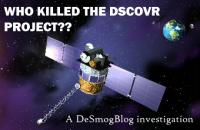My entry into the DSCOVR mission intrigue happened last year when I pitched the idea to SEED magazine for a feature article on the project.
DSCOVR was quietly killed by NASA in January 2006 and it seemed awfully strange to me that a fully completed climate satellite costing $100 million would be mothballed after it had been built.
Stranger still was that virtually every scientist I interviewed as I researched this piece expressed something between guarded disappointment to full-blown outrage that what they considered crucial mission had been canceled.
Project leader Dr. Francisco P. J. Valero, of the Scripps Institution of Oceanography, described the mission as “an urgent necessity”.
Dr. Robert L. Park, a professor of physics at the University of Maryland, was more blunt about the importance of DSCOVR’s data: “Not knowing may kill us.” He is on record as stating that sending DSCOVR to L1 is “the most important thing we could be doing in space right now.”
Other scientists were so nervous about talking about the cancellation, the agreed to only speak off the record. One was even worried that the National Security Agency was recording our conversation.
That seemed a bit weird.
So in May 2006, after I had filed my piece with SEED, I sent in a Freedom of Information Act (FOIA) request to NASA for any documents “in the possession of NASA Deputy Associate Administrator Dr. Mary L. Cleave touching on or relating to the decision to cancel the mission.”
Good thing I didn’t hold my breath, I would have died of asphyxiation sometime last year. I twice narrowed the scope of the request for NASA’s benefit. I was somewhat encouraged to receive a letter of acknowledgement on May 18 telling me that my request was being processed.
Then nothing. By August I started bugging NASA by email to see what was happening. I left several voice mail messages and unanswered emails and finally got this email in late October stating:
“Dear Mr. Anderson, I want to apologize for the length of time that it has taken to respond to your request. I appreciate your modified request and your patience.
I am working on your request and should have a package mailed out to you this week. I have reviewed the documents submitted to our office responsive to your request. At this time, I am asking for a quick review of the documents by our Office of the General Counsel.”
It’s important to note that federal agencies have a legal obligation to respond to FOIA requests within 20 working days. I was now up to 120 working days and getting pretty fed up, especially since the documents were apparently already collected and now held up by NASA lawyers. Then there is the small matter of the fate of the planet, but I digress…
The email assured me that the documents were going to be mailed “next week” and I was anxious to see what would be finally released. Little did I know that I facing another seven months of stonewalling.
In fact, NASA didn’t release any documents until April of 2007 – almost a year after filed my request. By then I was emailing them almost every day. And guess what? After keeping me waiting for over 250 days past their legal timeline, NASA withheld all internal documents relating to the decision to cancel DSCOVR.
What I got was 80 pages of mostly press clippings and letters from concerned scientists about the decision to cancel. A small selection of those letters are available here.
After beating my head against a wall for almost a year, I still felt compelled to keep digging on this strange story. So I filed an appeal to NASA seeking release of the withheld documents. It wasn’t until July of this year that I got my answer. Again, goose eggs.
NASA’s legal department determined that among other things, it was necessary to withhold all internal documents relating to the decision to kill DSCOVR “to protect against public confusion that might result from disclosure of reasons and rationales that were not ultimately the grounds for the Agency’s actions.”
NASA also relied on a legal privilege to protect “open frank discussions on matters of policy between supervisors and superiors …”.
That seems a bit thin. The climate models the DSCOVR would help calibrate are now driving some of the most sweeping public policy decisions in the world.
After spending billions of dollars on low-Earth orbit observations, current climate models still have an energy imbalance of 4-6 watts per square meter, which is two to three times larger than the effect of atmospheric CO2. The unique data DSCOVR would beam back from 1.5 million kilometers away would help resolve those uncertainties and provide the world a much clearer view of how bad climate change really is.
Yet NASA is not only refusing to launch DSCOVR after taking over $100 million in taxpayers money for the project, they are also refusing to release any documents about the reasons for canceling the mission.
So what is NASA hiding? Are they simply embarrassed by this fiasco? Is there some incriminating email from the White House telling NASA to kill the project? What else is going on here? Desmog Blog is now contemplating a legal challenge to pry open this cone of silence.
Next posting: The latest twist in this bizarre story.
This is part 3 in Mitchell Anderson’s investigative series on the DSCOVR climate satellite. Please help us in our research on this important project by donating to DeSmogBlog. Thanks to all those people who already have.
Subscribe to our newsletter
Stay up to date with DeSmog news and alerts






